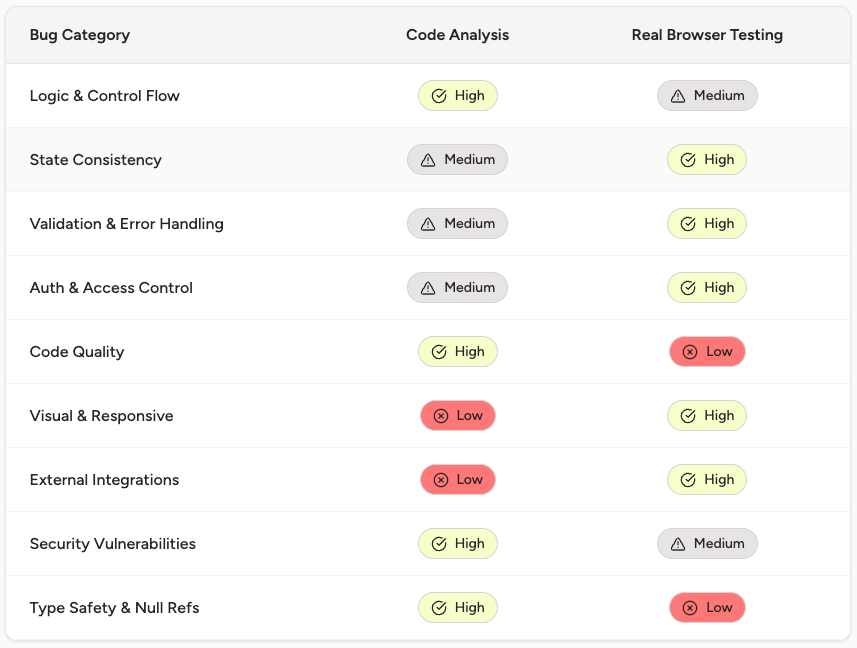Bugster vs. AI Code Review Tools: The Real Browser Advantage
Why testing your app like a real user complements analyzing code for comprehensive bug detection
Why This Comparison Matters
In frontend development, not all bugs are created equal. AI Code Review tools analyze your diff and examine code semantics, while AI E2E Testing tools execute your app like real users do.
Think of it like this: one tool reads your recipe, the other actually cooks the dish. Both approaches are valuable, but they surface very different kinds of mistakes. Understanding this split helps you build a bug detection strategy that doesn’t leave blind spots.
What AI Code Review Tools Do (Greptile, BugBot, CodeRabbit)
AI Code Review tools plug directly into your PRs. They analyze code semantics, logic patterns, guards, and validations. Their strength? Catching deterministic bugs in your source code before it ever ships.
Take Greptile: it understands your entire codebase context and spots complex logic errors, security vulnerabilities, and architectural anti-patterns that human reviewers often miss.
What these tools excel at:
Logic and control flow errors
Security vulnerabilities (SQL injection, XSS in code)
Code quality and maintainability issues
Architectural anti-patterns
Type safety and null reference errors
Dead code and redundancy detection
In short: they’re like having a super-powered static analysis reviewer who never gets tired.
What AI E2E Testing Tools Do (Bugster)
AI E2E tools like Bugster go down a different path: instead of reading your recipe, they step into the kitchen. Bugster spins up real browsers, navigates your app, clicks the buttons, fills the forms, and validates what happens in the messy, real-world runtime.
Bugster’s destructive agent adds another layer: it looks at your PR changes and stress-tests those modified areas directly. That means your new features and fixes get hammered under realistic conditions before users ever touch them.
What Bugster excels at:
User interaction flows and state consistency
Visual layout and responsive design issues
Real browser runtime errors
End-to-end user flows with external services
Performance under real network conditions
Bug Detection Matrix: What Each Tool Actually Catches
This is the core tradeoff: static tools safeguard your code logic; real-browser tools safeguard your user experience.
Illustrative Cases: When Each Tool Shines
Case 1: Authentication Token Expiration
The Code (passes all static analysis):
// This looks perfect to AI Code Review Tools
const AuthProvider = ({ children }) => {
const [token, setToken] = useState(localStorage.getItem('token'));
const refreshToken = async () => {
const response = await fetch('/api/refresh');
const newToken = await response.json();
setToken(newToken);
};
return (
<AuthContext.Provider value={{ token, refreshToken }}>
{children}
</AuthContext.Provider>
);
};
What AI Code Review Tools catches: Logic is sound, no security vulnerabilities in code
What Bugster catches:
User gets logged out mid-checkout because token expires
Refresh mechanism fails on slow connections
User loses form data when authentication redirects occur
Error messages don't appear properly when auth fails
Case 2: Calendar End-of-Month Edge Case
The Code (perfect logic according to static analysis):
// AI Code Review Tools sees no issues here
function getNextAvailableDate(currentDate) {
const next = new Date(currentDate);
next.setDate(next.getDate() + 1);
return next;
}
What AI Code Review Tools catches: The date logic is mathematically correct
What Bugster catches:
Calendar breaks when users select January 31st (next month has no 31st)
Date picker shows impossible dates in February
Timezone shifts cause booking conflicts
Mobile date picker has different behavior than desktop
Case 3: Third-Party Checkout Integration
The Code (passes all code review standards):
// AI Code Review Tools approves this implementation
const processPayment = async (paymentData) => {
try {
const result = await stripe.createPaymentIntent(paymentData);
return { success: true, paymentIntent: result };
} catch (error) {
return { success: false, error: error.message };
}
};
What AI Code Review Tools catches: Error handling is properly implemented, no obvious security issues
What Bugster catches:
Stripe modal doesn't load on slow 3G connections
Payment succeeds but confirmation page fails to load
Users can double-click and create duplicate charges
Payment form breaks when browser blocks third-party scripts
Success/failure states don't update UI properly
The Complementary Strategy: AI Code Review + Bugster
This isn’t about picking sides. The strongest teams layer both approaches.
1. Pre-Commit: AI Code Review
Catches logic errors, security vulnerabilities, and quality issues
Instant feedback in PR workflow
2. Pre-Deploy: AI E2E Testing (Bugster)
Validates user experience in real browsers
Exercises integrations, state, and UX edge cases
Ideal CI/CD Pipeline:
┌─────────────────┐
│ Code Review │ ← Greptile, BugBot catch logic
│ Static Analysis │ & security bugs in source code
└─────────────────┘
↓
┌─────────────────┐
│ Real Browser │ ← Bugster catches user experience
│ Testing │ bugs in actual environment
└─────────────────┘
↓
┌─────────────────┐
│ Production │ ← Maximum bug prevention
└─────────────────┘
Call to Action: Activate both layers: AI code reviewer on PRs + Bugster on preview environments for your 5 core user flows. This combination gives you comprehensive coverage from code quality to user experience.
Conclusion: Two Tools, One Mission
AI Code Review Tools keep your codebase logically sound and secure. Bugster ensures that sound code translates into a seamless user experience.
The future of frontend isn’t static analysis or real browser testing, it’s both. Together, they give you confidence from commit to production.
Ready to see what your code reviewers can’t? Try Bugster’s destructive testing on your next PR and find the UX bugs hiding in plain sight.





